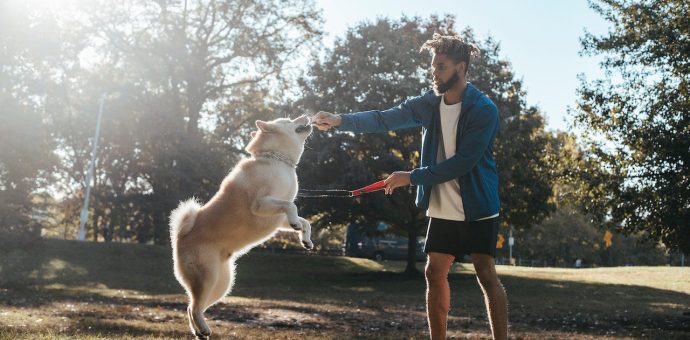Dog training is one of the most important things by which you can do to establish a happy and healthy association with your furry buddy. It not only makes your dog more obedient and well-behaved, but it also enhances your relationship with your pet.
We will address all you need to know to train properly your dog in this systematic and comprehensive guide.

Table of Contents
1. Setting Goals for Your Dog Training
It’s crucial to have clear objectives before starting to train your dog. These objectives must be precise, measurable, realistic, and achievable. You might define training objectives for your dog such as the following:

- Teach your dog basic obedience commands like sit, stay, come, and heel.
- Training your dog to walk calmly on a leash without pulling.
- Teach your dog to stay quiet on command and not bark excessively and unnecessarily.
- Potty training your dog to go outside or on a designated pad.
2. Understanding Dog Behavior
It’s critical to have a proper understanding of dog behavior in order to train your dog efficiently. Dogs are sociable creatures with a natural desire to form themselves into groups. It is your duty as the owner to position yourself as the pack leader and train the dog to obey you.
3. Positive Reinforcement Training
A training method known as positive reinforcement rewards your dog for good behavior rather than punishing them for bad behavior. Based on the idea that the behavior which is rewarded most is more likely to be repeated again, this kind of training is used.

4. Consistency and Patience
Consistency and patience are the vital key when talk about dog training. Dogs thrive on routine and repetition, so it’s important to be consistent in your training methods and to have patience when your dog doesn’t get it right away.
Consistency is an essential key in dog training. Your dog needs to understand that certain behaviors are expected of them at all times. You should use the same commands and rewards continuously and consistently to avoid confusion.
Consistency also means setting up realistic expectations and goals in your dog training progress. You should not expect your dog to learn everything overnight. Instead, you should work on their training a little bit each day and celebrate small successes all the time.
Read More >> 10 Most Common Dog Behavior Problems
Patience is also a vital key in dog training. It is possible that your dog will not acquire a new habit straight away, and that results will take time to appear. When your dog does not behave as expected, you should avoid being disappointed or angry with them.
Instead, keep a positive attitude and reinforce good behavior when you see it. It’s also crucial to keep in mind, each and every dog is unique that may require different training methods.

5. Dog Training Techniques
There are many different ways you may train your dog. The following are the most widely used methods. Here is some detailed information about the variety of dog training methods you may use:
Dog Training Technique | Description |
Clicker training | It is a form of positive reinforcement training that uses a clicking sound to mark good behavior. |
Leash and collar training | A method of teaching your dog to walk calmly on a leash without pulling. |
Crate training | A technique that involves teaching your dog to associate their crate with safety and security. |
Potty training | A method of teaching your dog where and when it’s appropriate to go potty. |
5.1 Clicker Training:
A common training method that employs positive reinforcement to teach your dog new actions is clicker training. This method involves marking excellent behavior with a characteristic clicking sound made by a clicker, followed by a reward like a treat or praise. Your dog will eventually come to identify the clicking sound with rewarding behavior, making it simpler to teach them new skills.
5.2 Leash and Collar Training:
Leash and collar training is a technique for teaching your dog to walk comfortably on a leash without pulling. This method involves using a collar and leash to guide your dog’s movements and praises positive behavior. Begin by introducing your dog to the collar and leash in a positive manner, and then gradually increase the length of time your dog wears them.
5.3 Crate Training:
Crate training is a method of training your dog to associate his or her crate with safety and security. This method may be used for potty training as well as keeping your dog safe and secure while you are gone.
To crate train your dog, begin by gently introducing them to the crate and gradually increasing the amount of time they spend inside. You may also use goodies and praise to promote positive behavior while your dog is in the crate.

5.4 Potty Training:
Potty training is a process of teaching your dog where and when to relieve himself. This technique involves building up a constant routine for your dog, including regular feeding and potty breaks.
You should also employ positive reinforcement to encourage your dog for going potty in the proper location rather than penalizing them for accidents.
6. Troubleshooting Common Problems
Even with the best training methods, you may encounter some common challenges while teaching your dog. For example, your dog may not react to a certain instruction or may express undesirable habits like chewing or digging, Barking excessively, Jumping up on people, Pulling on the leash, etc. When this happens, you must keep yourself calm and avoid becoming angry or frustrated.
- Barking excessively
- Jumping up on people
- Chewing on inappropriate items
- Pulling on the leash
6.1 Barking excessively:
Excessive barking may be annoying for you as well as your dog. To overcome this issue, you should first try to figure out what is prompting the barking. Is your dog barking out of anxiety, boredom, or a need for attention?
Once you’ve found the underlying cause, you may develop a training method to address the behavior. This may require training your dog to be quiet on command, offering extra physical and mental stimulation, or resolving any underlying anxiety concerns.
6.2 Jumping up on people:
Jumping up on people is a typical issue, particularly in puppies and younger dogs. To address this conduct, it’s critical to continuously reinforce the desired behavior, which is for your dog to greet visitors with all four paws on the ground.
Training your dog to sit or stand calmly when people approach and rewarding them for such excellent behavior. You might focus on teaching your dog an alternate activity, such as playing with a toy or gentle walking, when they are enthusiastic or afraid.

6.3 Chewing on inappropriate items:
Dogs naturally like to chew, but when they start chewing on inappropriate things like furniture or shoes, it may become a problem. To resolve this problem, offer your dog lots of suitable chew toys, and remain vigilant by keeping an eye on them.
The “leave it” command may also need to be practiced with your dog in order to divert their attention to acceptable objects.
6.4 Pulling on the leash:
Dogs that are learning to walk on a leash often have problems with leash pulling. Using positive reinforcement strategies, such as clicker training or rewarding excellent behavior with food or praise, you should start by teaching your dog to walk peacefully on a leash in order to address this problem.
You may also need to invest in a no-pull harness or head collar, which can help reduce pulling and make walks more enjoyable for both you and your dog.
Read More >> Solve Your Dog Barking Problem: Try these Methods
7. Conclusion
In conclusion, dog training is an integral part of pet ownership. We believe that this comprehensive guide will give you the information and resources you ought to properly train your dog and develop a strong and pleasant bond with your canine companion. Your dog will be well-behaved and obedient in no time if you are persistent and patient and apply positive reinforcement training methods.
Generally, the key to effective dog training is to determine the strategies that work best for your dog and your individual training objectives. Whether you use clicker training, leash and collar training, crate training, or potty training, consistency, patience, and positive reinforcement are crucial to attaining results.
Certainly! In this article, we have provided a comprehensive guide to help pet owners successfully train their dogs. We covered important topics such as setting goals for dog training, understanding dog behavior, positive reinforcement training, consistency and patience, and troubleshooting common problems. We also provided a mermaid diagram to help visualize the flow of the article.






